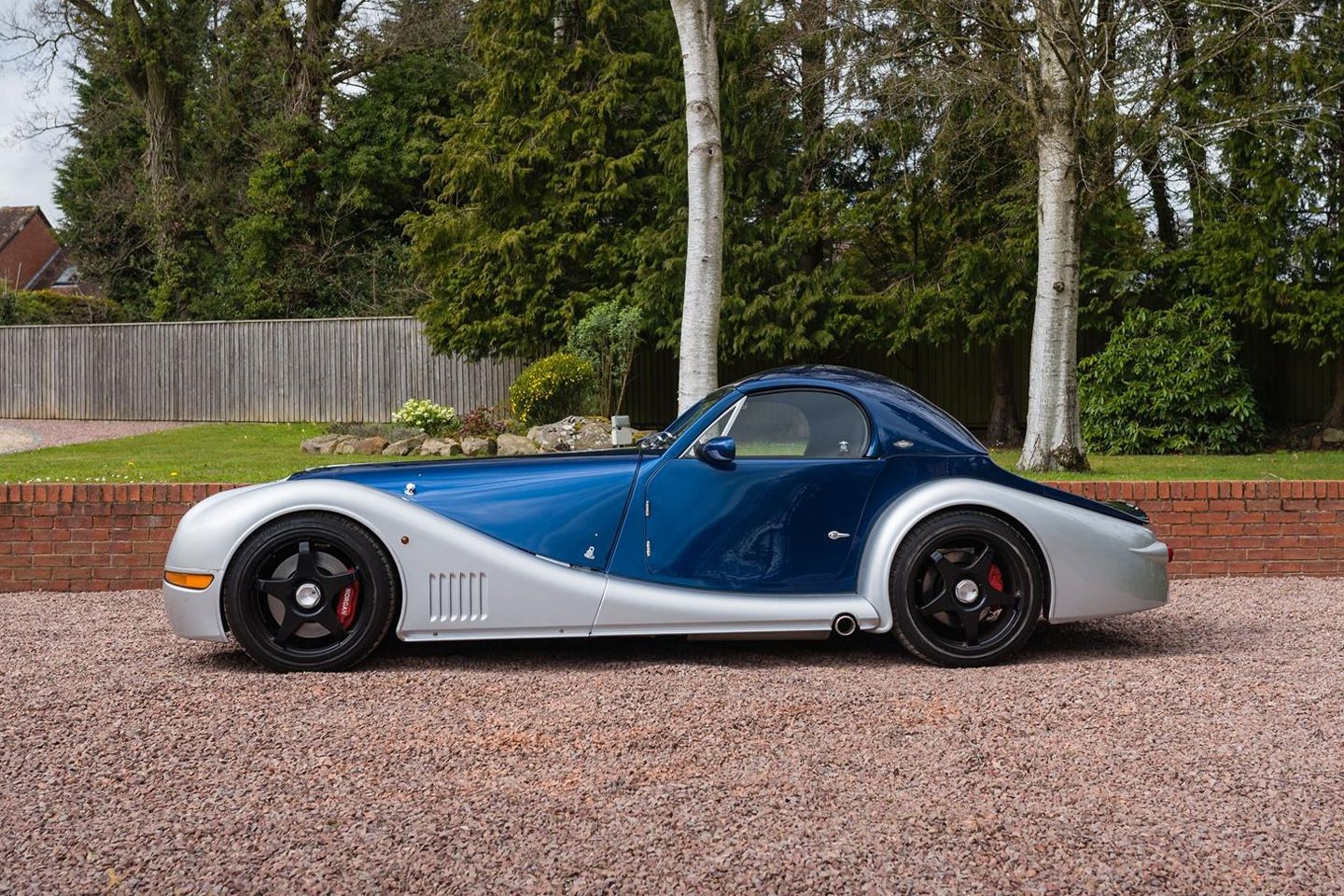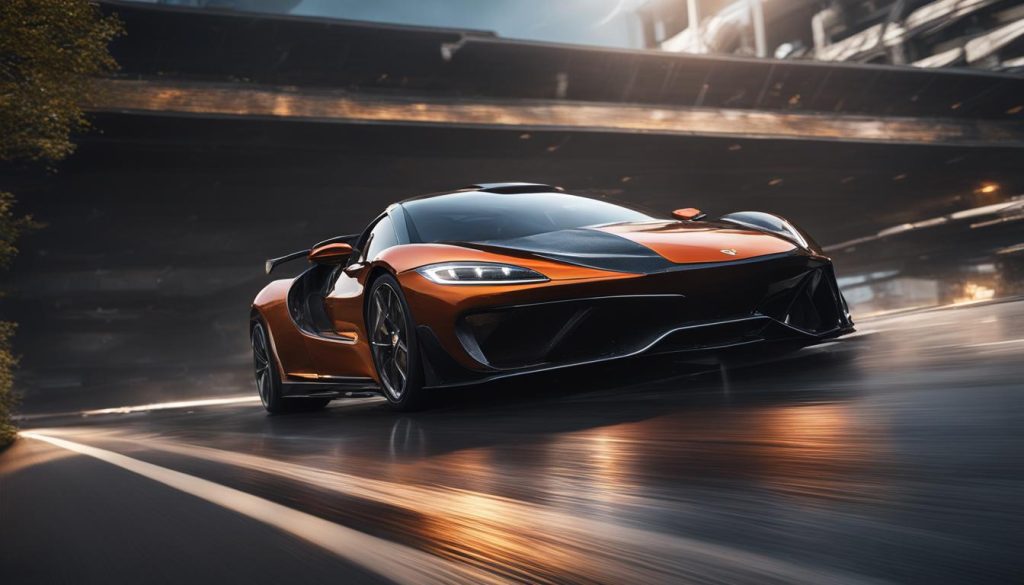
Key considerations
- Available for £48,000
- 4.4-4.8 V8 petrol twin-turbo, rear-wheel drive
- Vintage style with modern(ish) underpinnings
- Wonderful noise on side pipes
- Drivetrains are getting old now, later autos are good
- Value retention could/should equal free motoring
Morgan was never known for making ‘new’ cars. From 1964 to the end of the 20th century all of its output was based on the same Plus Four shape and design – until the millennium brought the Aero 8 that is the subject of this buying guide.
For the Aero 8 Morgan hauled itself into the modern age. The traditional styling was blended with pukka chassis elements including rose-jointed double wishbone independent inboard suspension and centre-lock magnesium wheels. There was ash in the frame but the chassis was riveted and bonded aluminium and the body panels were ‘superformed’ alloy. There were no anti-roll bars but you did get Eibach springs with your Koni dampers. A limited-slip diff was also part of the spec but apart from that you were pretty much on your own as far as driver aids were concerned, all part of the fun as far as the typical Morgan owner was concerned.
The engine was BMW’s 286hp/322lb ft M62 single VANOS 4.4-litre V8, as previously seen in the turn of the century E38/39 740i and 540i and the 2002-on Range Rover. In the 1,135kg Morgan, where it was mated to a six-speed Getrag manual gearbox, the M62 delivered a 4.8-second-0-60mph time and a top speed (if you were brave enough to go for it) of 160mph.
The distinctive front-end look was achieved, if that’s the right word for it, by fitting reversed VW Beetle headlamps. Morgan tried to ignore the ‘crosseyed’ jibes, stating that the VW units were selected for aerodynamic reasons, but the launch of the series 3 in 2005 with the slightly less buggy Mini lights rather confirmed that it was force majeure for the series 1 rather than an actual choice. Morgan had tried to get the Mini lights from the start but BMW had knocked back that request on the grounds of not wanting any thunder to be stolen from their new baby.

There were just over 200 series 1 cars Aero 8s built between 2000 and 2004 when the run-out GTN came out as a roadgoing nod to Morgan’s Aero GT Le Mans racers. Using the 330hp 4.6 Alpina version of the M62 engine, the side-exhausted blue and grey GTNs had a claimed top speed of 165mph, stiffened suspension, semi-slick tyres and cabins done out in a mix of black wood and carbon fibre with the classy finishing touch of a Moto-Lita steering wheel. Eleven GTNs were made. One of these was for sale on PH Classifieds at the time of writing (June ’23). We’ll link you to that at the end.
In 2004 the series 2 Aero 8 was released featuring revisions that would allow it to go on sale in the US, principally a repositioned petrol tank but also (no stereotyping intended) with extra width in the passenger compartment and boot, which obviously received a new lid. The roof was new too for the same reason, and so was the engine, BMW’s 333hp/331lb ft Valvetronic N62B44 4.4 litre V8, the first engine (we think) to use a continuously variable-length intake manifold. This motor saw the Aero 8 out to the end of production, the crank being upgraded from cast iron to steel in 2005. GTN-style side exhausts were offered as an option. A hardtop GT Coupe arrived at this time. A total of sixty or so series 2 cars were built in a mix of left- and right-hand drive.
The defining characteristic of the series 3 (2005-07) was a new front end with the aforementioned Mini lights. There were those who felt that this cost the car some character. Eeeh, there’s no pleasing some folk. Around 200 of these cars were made.
The final Aero 8, the series 4, ran from 2007 to 2010 with the N62B48 V8 now displacing 4.8 litres and putting out 362hp/370lb ft. A six-speed ZF 6HP26 auto transmission became available for the first time. The fuel tank was moved again, this time for better weight distribution. New white-on-black clocks replaced the old cream-faced dials and were joined by new vents and a conventional handbrake. Luggage space was increased and the body sported new vents and intakes. Again the side pipes were an option, this time as part of a Performance Pack which also included red brake calipers and a gloss black diffuser.

The last ‘phase one’ Aero 8 trundled out of Malvern in 2010, with the stunningly-styled art deco AeroMax and Supersport variants overlapping the 8 from 2008/09, more than three years after the first AeroMax appeared as a one-off commission. A fixed-head Aero Coupe came out in 2012.
In 2015 a series five Aero 8 appeared. It was quite different to what had gone before, featuring a 10 per cent stiffer chassis, conventional outboard wishbone suspension with coilovers and anti-roll bars, a 370hp version of the 4.8-litre engine, AeroMax front end, new body panels from the A-pillars back, Supersports-style boat-tail rear, and a nicely faired-in convertible roof in place of the usual ‘pram style’ top. It came in either manual or automatic forms.
That car, and the Aero 8 line, came to a final end in 2018 by which point the 8 was priced at just over £94,000. The last hurrah was an eight-off run of Aero GTs using a 367hp/370lb ft version of the 4.8 litre V8, which turned out to be the final iteration worldwide of the naturally aspirated BMW engine. The carbonfibre-rich GT was good for a 170mph top speed. Its 0-62mph time of 4.5sec was no different to earlier Aero 8s. GT prices started at £144,000 but the customisation options were as wide as the grin on your face so most GTs were a lot more expensive than that.
When Aero Coupes come up for sale they’re generally priced at £175k-£180k. 38 of those were made. 100 AeroMaxes were scheduled to be built, 19 of them right-hand drive, but despite the Max’s commonness relative to the Coupe it exotic bodyshape has made it the most desirable Aero, prices typically running at between £200k and £210k. We’re going to be concentrating on the older pre-series 5 Aero 8s here. Three or four years ago prices for these started at around £40k, but by mid-2023 that entry price had grown by nearly £10k. The figures in our spec panel relate to the 2004/05 series 2.
SPECIFICATION | MORGAN AERO 8 (2004/05 series 2)
Engine: 4,398cc V8 32v
Transmission: 6-speed manual, rear-wheel drive
Power (hp): 333@6,100rpm
Torque (lb ft): 332@3,600rpm
0-62mph (secs): 4.5
Top speed (mph): 160
Weight (kg): 1,132
MPG: 25
CO2 (g/km): 264
Wheels (in): 18
Tyres: 225/40 (f), 245/40 (r)
On sale: 2000 – 2018
Price new: £50,000 (2001)
Price now: from £48,000
Note for reference: car weight and power data is hard to pin down with absolute certainty. For consistency, we use the same source for all our guides. We hope the data we use is right more often than it’s wrong. Our advice is to treat it as relative rather than definitive.

ENGINE & GEARBOX
The best way to drive an early manual Aero 8 was to stick it in one of the intermediate gears and leave it there, cutting out the unfulfilling long-throw shift and relying instead on the high-torque/low-weight equation to thrust you hither and yon with consummate ease. Even fourth gear would give you serious midrange acceleration figures like 30-50mph in 3.6sec, and the noise through the side-exit exhausts would have put a smirk on Satan’s face.
None of the BMW V8s could be deemed particularly reliable. The M62 suffered from failed plastic timing chain guides which caused chain stretch. This would illuminate the CEL and cause noisy startup and running. VANOS failure would create a rattle on cold starts and a clanking noise when warm, along with a drop in power and poor idling, although that last one could also be caused by any number of other issues including plugs, coils, vacuum leaks, or problems with the PCV valve and MAF sensor. Valve covers leaked oil. Radiators and expansion tanks blew. Engine mounts failed.
The N62 got a reputation for munching through valve seals and it could be any (or all) of the 48 valves affected. Smoking and heavy oil consumption were the unsurprising symptoms of this. Leaks from the valve cover and alternator bracket gaskets were fairly common too, as were leaks from the coolant transfer pipe. The oil filter O-ring often went dry and hard, leading to more leaks. The coolant pipe issue could be massively expensive to fix conventionally as serious engine teardown was involved (up to and including cylinder head removal) to reach the offending area. Having said that, aftermarket fixes have since been devised including something that’s a bit like a heart stent. This only required the removal of the water pump, significantly reducing labour costs.

The service schedule is 10,000 miles but it was important to see evidence of the first 1,000-mile service on the paperwork. Pre-’07 cars were supposed to be inspected every six months. Fixed price servicing through Morgan will cost £70 for a health check, £542 for an interval service and £898 for the full, all excluding VAT. The high days and holidays nature of the car made it wise to invest in a trickle charger/conditioner for the gel battery.
The driveline shunt that had been quite noticeable in the series 1 cars was mainly down to the sharpness of the clutch. This was reduced in the series 2 but all manuals suffered to some extent from the on-off clutch feel. It might seem like the gearbox is quite noisy but that’s more a reflection of the soundproofing that BMW put in its cars than a negative comment on the box. By the time Morgan had reached the end of the Aero 8 line in 2018 the operation of the manual box had become a lot more satisfying.
In the ’07-’10 series 4 cars the 6HP26 auto gave access to the redline in each gear in Sport manual mode and blipped the throttle for downchanges. The extra dimension that the 6HP brought to the car had more than one early-series owner trading up to it. Elsewhere, pinion seals on the back axle were known to weep. Parts to fix it weren’t expensive but it wasn’t a ten-minute job. Starter motors could stick on series 1 cars.

CHASSIS
The prospect of driving an Aero 8 for the first time could be a daunting one. The front axle seemed to be an awfully long way away from the steering wheel, but in reality the rearward mounting of the engine and the extreme stiffness of the chassis quickly put you at your ease – and besides, the 8 wasn’t as long as appearances would have you believe. It was actually only six inches longer than an MX-5.
As with the drivetrain, chassis performance was greatly improved by the end of the 8’s production run but the steering could never be described as inspiring, the lack of self-centring requiring more manual wind-back by the driver than might have been seen as desirable. There was a fair bit of bump steer too. Power steering pumps failed but they weren’t expensive to replace.
The suspension felt a little underdamped and the brakes on the first cars especially weren’t great on feel, or fade if you were using them hard. Fortunately for the firm’s reputation, few owners drove Morgans hard. There was no such thing as a stability control system on any Aero 8 but strong grip (on dry roads at least) meant that this was rarely a source of concern. The growing availability of increasingly talented tyres over the years plus a power output that never topped 400hp undoubtedly helped the Aero 8’s safety cause and even sub-300hp series 1s owners felt more than fast enough to deliver plenty of frolicsome fun.
OZ magnesium wheels on the series 1s were prone to cracking if you hit a pothole. It was important to check them properly, ie on the inside as well as the outside. Five-stud wheels appeared on later (’03-on) series 1 cars, which are colloquiallly known as 1.5s. Wheel bearings didn’t usually last for more than 20,000 miles. Front suspension lower ball joints will often be tired on early cars. The parking brake never worked that well.

BODYWORK
With that cow-scooping front end, stone chipping was a way of life on Aero 8s, and not just on the front: the bottom edges of the wings at both ends of the car were vulnerable to pebble-dashing too.
There’s no such thing as a waterproof Morgan. On both series 1 and series 2 cars the rain can come in not only through the usual convertible weak spot between the hood and the window tops but also between the hood and windscreen. The windscreen wipers were tiny and pretty ineffectual even when they were in optimal working order. Water could get past the glass on those Beetle headlamps too. Window winding mechanisms weren’t fault-free on early cars. Indicator wiring could become detached.

INTERIOR
The inside of an Aero 8 was pretty classy. The materials were right and generally well put together, although it would be a mistake to expect perfect matching up of the wood veneers and some first buyers’ ideas of leather/woodstain colour combos might not coincide with yours.
The interiors could look old before their time, or nicely worn-in depending on your perspective. The seats were comfy over long distances though and you also got decent creature comforts like air con, cruise, and a heated windscreen, which was quite handy as it helped you to keep the inside of the glass dry, what with the hood not being watertight. All part of the classic experience, sir/madam.
The seat adjustment mechanism didn’t always function perfectly and the seatbelt stitching could work loose. Some internal door mechs failed.

PH VERDICT
Today, in 2023, your choice of new Morgans is restricted to a three-wheeled Super or, if you insist on the normal number of wheels, a Plus Four or Six. The cheapest new four-wheeler, powered by a turbo 2.0 four, will cost you about £70,000 before you start adding options. In light of this, you might be tempted by the prospect of paying under £50k for a value-retaining Aero 8 with a rortmongous V8 motor.
It was a shame that the political exigencies of engine supply knocked the Aero 8 on the head because by the time it was phased out it had reached an impressive level of driveability and specialness. That was on top of the Morgan’s unique look and aura that ensured you would be the one answering loads of questions at any car show, irrespective of what else was on display. That along with the low numbers built makes an Aero 8 a good investment, not just for financial reasons but also from a fun driving point of view.
The most afffordable Aero 8 on PH Classifieds at the time of writing was this ’02 series 1 4.4 manual with 28,000 miles and a £48k price tag. For sale by the same private owner was this ’03 series 1.5 manual with a rare rear wing at £52k. His plan is to sell one not both cars to fund a housebuilding project.
Just under £65k will put you into this 2009 4.8 automatic with 26,000 miles and side-exit exhausts (pictured) but you’ll need another £30k for this £94,500 GTN (also pictured). In 2010 a very similar-looking car, maybe the same one, was auctioned for £42,750. Purely for illustrative purposes, given that we haven’t covered series 5 cars in this guide, £100k will be the target price for one of these later cars. Here’s a nice 2016 example for just under that amount, freshly returned from a Euro holiday. Sounds like a plan.
#Morgan #Aero #Buying #Guide













